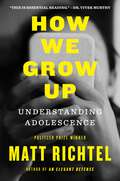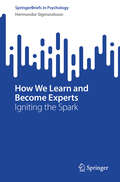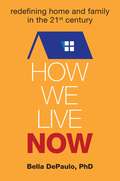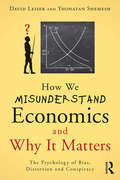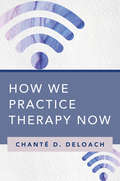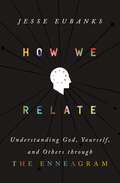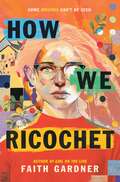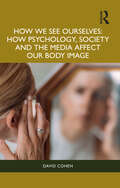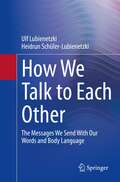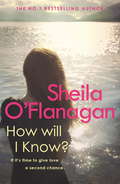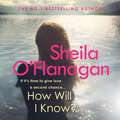- Table View
- List View
How We Eat with Our Eyes and Think with Our Stomach: The Hidden Influences That Shape Your Eating Habits
by Brian Wansink Carolin Sommer Melanie Mühl Diana Von Kopp“Cut through the juice cleanses and paleo diets to bring back some common sense.”—The New York Times Book ReviewOutsmart Your Impulses and Eat Better A Belgian chocolate cake topped with a velvety homemade mousse catches your eye on the menu. The next thing you know, you’ve ordered it—despite the hefty price. But do you know why? Through over 40 compelling questions, this book explores how our eating decisions tread the line between conscious and subconscious, and enables us to be more intelligent about food. With expert insights that draw from psychology, neuroscience, popular culture, and more, learn to see the innumerable influences behind your diet and cravings—from the size and color of your plate, to the placement of products in a supermarket, to the order in which you sit when out with friends. And the chocolate cake? Would you believe research shows that regional descriptions (Belgian!) and emotive, sensory language (homemade! velvety!) subtly affect your appetite? Know what and why you eat, when and how you do—before you next sit down to dine!
How We Grow Up: Understanding Adolescence
by Matt Richtel"This is essential reading for parents." — Dr. Vivek Murthy, former U.S. Surgeon GeneralGreatly expanding his award-winning New York Times series on the contemporary teen mental-health crisis, Pulitzer Prize–winning science reporter Matt Richtel delivers a groundbreaking investigation into adolescence, the pivotal life stage undergoing profound—and often confounding—transformation.One of The New Yorker's Best Books of 2025The transition from childhood to adulthood is a natural, evolution-honed cycle that now faces radical change and challenge. The adolescent brain, sculpted for this transition over eons of evolution, confronts a modern world that creates so much social pressure as to regularly exceed the capacities of the evolving mind. The problem comes as a bombardment of screen-based information pelts the brain just as adolescence is undergoing a second key change: puberty is hitting earlier. The result is a neurological mismatch between an ultra-potent environment and a still-maturing brain that can lead to anxiety, depression, and other mental health challenges. It is a crisis that is part of modern life but can only be truly grasped through a broad, grounded lens of the biology of adolescence itself. Through this lens, Richtel shows us how adolescents can understand themselves, and parents and educators can better help.For decades, this transition to adulthood has been defined by hormonal shifts that trigger the onset of puberty. But Richtel takes us where science now understands so much of the action is: the brain. A growing body of research that looks for the first time into budding adult neurobiology explains with untold clarity the emergence of the “social brain,” a craving for peer connection, and how the behaviors that follow pave the way for economic and social survival. This period necessarily involves testing—as the adolescent brain is programmed from birth to take risks and explore themselves and their environment—so that they may be able to thrive as they leave the insulated care of childhood.Richtel, diving deeply into new research and gripping personal stories, offers accessible, scientifically grounded answers to the most pressing questions about generational change. What explains adolescent behaviors, risk-taking, reward-seeking, and the ongoing mental health crisis? How does adolescence shape the future of the species? What is the nature of adolescence itself?
How We Know What Isn't So: The Fallibility Of Human Reason In Everyday Life
by Thomas GilovichGilovich illustrates his points with vivid examples and supports them with the latest research findings in a wise and readable guide to the fallacy of the obvious in everyday life.
How We Learn and Become Experts: Igniting the Spark (SpringerBriefs in Psychology)
by Hermundur SigmundssonThis book explores how we learn new skills and knowledge. The book also focuses on how we become experts. Currently, there is an understanding that experts and expertise are made, and thus, deliberate practice and follow-up are needed over time to excel over the years. This volume will also analyze which factors may be important to be able to train your brain and behavior to develop expertise. Passion may be one such factor; others may be grit and a growth mindset.
How We Learn: The Surprising Truth About When, Where, and Why It Happens
by Benedict CareyIn the tradition of The Power of Habit and Thinking, Fast and Slow comes a practical, playful, and endlessly fascinating guide to what we really know about learning and memory today--and how we can apply it to our own lives. From an early age, it is drilled into our heads: Restlessness, distraction, and ignorance are the enemies of success. We're told that learning is all self-discipline, that we must confine ourselves to designated study areas, turn off the music, and maintain a strict ritual if we want to ace that test, memorize that presentation, or nail that piano recital. But what if almost everything we were told about learning is wrong? And what if there was a way to achieve more with less effort? In How We Learn, award-winning science reporter Benedict Carey sifts through decades of education research and landmark studies to uncover the truth about how our brains absorb and retain information. What he discovers is that, from the moment we are born, we are all learning quickly, efficiently, and automatically; but in our zeal to systematize the process we have ignored valuable, naturally enjoyable learning tools like forgetting, sleeping, and daydreaming. Is a dedicated desk in a quiet room really the best way to study? Can altering your routine improve your recall? Are there times when distraction is good? Is repetition necessary? Carey's search for answers to these questions yields a wealth of strategies that make learning more a part of our everyday lives--and less of a chore. By road testing many of the counterintuitive techniques described in this book, Carey shows how we can flex the neural muscles that make deep learning possible. Along the way he reveals why teachers should give final exams on the first day of class, why it's wise to interleave subjects and concepts when learning any new skill, and when it's smarter to stay up late prepping for that presentation than to rise early for one last cram session. And if this requires some suspension of disbelief, that's because the research defies what we've been told, throughout our lives, about how best to learn. The brain is not like a muscle, at least not in any straightforward sense. It is something else altogether, sensitive to mood, to timing, to circadian rhythms, as well as to location and environment. It doesn't take orders well, to put it mildly. If the brain is a learning machine, then it is an eccentric one. In How We Learn, Benedict Carey shows us how to exploit its quirks to our advantage.
How We Learn: Why Brains Learn Better Than Any Machine . . . for Now
by Stanislas DehaeneAn illuminating dive into the latest science on our brain's remarkable learning abilities and the potential of the machines we program to imitate themThe human brain is an extraordinary machine. Its ability to process information and adapt to circumstances by reprogramming itself is unparalleled and it remains the best source of inspiration for recent developments in artificial intelligence. In How We Learn, Stanislas Dehaene decodes the brain's biological mechanisms, delving into the neuronal, synaptic, and molecular processes taking place. He explains why youth is such a sensitive period, during which brain plasticity is maximal, but assures us that our abilities continue into adulthood and that we can enhance our learning and memory at any age. We can all learn to learn by taking maximal advantage of the four pillars of the brain's learning algorithm: attention, active engagement, error feedback, and consolidation.The exciting advancements in artificial intelligence of the last twenty years reveal just as much about our remarkable abilities as they do about the potential of machines. How We Learn finds the boundary of computer science, neurobiology, and cognitive psychology to explain how learning really works and how to make the best use of the brain's learning algorithms, in our schools and universities, as well as in everyday life.
How We Live Now
by Bella DepauloA close-up examination and exploration, How We Live Now challenges our old concepts of what it means to be a family and have a home, opening the door to the many diverse and thriving experiments of living in twenty-first century America.Across America and around the world, in cities and suburbs and small towns, people from all walks of life are redefining our "lifespaces"--the way we live and who we live with. The traditional nuclear family in their single-family home on a suburban lot has lost its place of prominence in contemporary life. Today, Americans have more choices than ever before in creating new ways to live and meet their personal needs and desires. Social scientist, researcher, and writer Bella DePaulo has traveled across America to interview people experimenting with the paradigm of how we live. In How We Live Now, she explores everything from multi-generational homes to cohousing communities where one's "family" is made up of friends and neighbors to couples "living apart together" to single-living, and ultimately uncovers a pioneering landscape for living that throws the old blueprint out the window. Through personal interviews and stories, media accounts, and in-depth research, How We Live Now explores thriving lifespaces, and offers the reader choices that are freer, more diverse, and more attuned to our modern needs for the twenty-first century and beyond.
How We Misunderstand Economics and Why it Matters: The Psychology of Bias, Distortion and Conspiracy
by David Leiser Yhonatan ShemeshThis is the first book to explain why people misunderstand economics. From the cognitive shortcuts we use to make sense of complex information, to the metaphors we rely on and their effect on our thinking, this important book lays bare not only the psychological traits that distort our ability to understand such a vital topic, but also what this means for policy makers and civil society more widely. Accessibly written, the book explores the mismatch between the complexities of economics and the constraints of human cognition that lie at the root of our misconceptions. The authors document and explain the gamut of cognitive strategies laypeople employ as they grapple with such complex topics as inflation, unemployment, economic crises, finance, and money in the modern economy. The book examines sources of misconceptions ranging from the intentionality fallacy, whereby economic phenomena are assumed to have been caused deliberately rather than to have come about by an interplay of many agents and causal factors, to the role of ideology in framing economic thinking. Exposing the underlying biases and assumptions that undermine financial and economic literacy, and concluding with recommendations for how policies and ideas should be framed to enable a clearer understanding, this will be essential reading not only for students and researchers across psychology and economics, but also anyone interested in progressive public policy. Visit the associated website for the book here: http://www.misunderstandeconomics.com/
How We Practice Therapy Now
by Chanté D. DeLoachEssential approaches to clinical practice for today’s out-of-office world. Future psychotherapy is not confined to the office: it can be online, virtual, wellness-oriented, flexible, racially conscious, and in service of public wellness. COVID-19 has forever changed the landscape of psychotherapy in these ways, and in ways we have yet to discover. Practicing psychologist Chanté D. DeLoach invites readers to reflect on the state of psychotherapy and emerging potentialities forged through crisis. She presents key concepts of telemental health, concierge therapy, and other out-of-office approaches to psychological well-being. DeLoach provides step-by-step guidance on getting started in telemental health, and points to clinical, ethical, and legal considerations for clinicians working in a digital space and other nontraditional formations. Topics covered include: how to screen clients for the appropriateness of teletherapy; the required equipment and infrastructure, demystifying the different online platforms; ways to set up a warm and inviting online office, and legal and ethical issues of remote therapy. It also considers business and practice management issues such as what to include in an informed consent for teletherapy. Important discussions of race, intersectionality, and justice in teletherapy round out the book. Readers will be invited to critically reflect on their own identities and comfort in integrating the challenging issues of race, power, and privilege in clinical work. Through interwoven examples and reflective exercises, Dr. DeLoach provides tools to support practitioners as they reimagine their clinical identities to meet the needs of today’s clients. This book offers keen insights and learning for all clinicians, from trainees to seasoned practitioners, who are embarking on this new terrain.
How We Relate: Understanding God, Yourself, and Others through the Enneagram
by Jesse EubanksAn Enneagram book like no other, How We Relate helps you discover how God speaks into your unique personality and life story to make the gospel come alive for you. In How We Relate, Enneagram coach and host of The EnneaCast podcast Jesse Eubanks invites you to discover who you are. In this illustrated guide, he expertly utilizes the Enneagram to lead you to the heart of Jesus, where you will find the wholeness you long for. As you peel back the layers of your False Self, encounter Jesus, and experience the redemption of your True Self, you will discover how to:Understand your personality and the personalities of othersExplore your distinct approach to relationshipsDiscover how Jesus empathizes with and heals your unique core woundInterpret the Enneagram through the gospel storyExperience more meaningful relationships with God, others, and yourself Life is about relationships. It's time to transform yours.
How We Ricochet
by Faith GardnerFor readers of This Is How It Ends and All the Bright Places, How We Ricochet takes an intimate and unflinching look into the devastating consequences of a mass shooting for one girl and her close-knit family, from Faith Gardner, acclaimed author of Girl on the Line. It seems sometimes a charade that we continue celebrating in the face of relentless tragedy. How dare we? But then . . . what else is there to do?Betty’s mom needed new pants for her job.That was why Betty was at the mall with her mom and sister when the shooting started.Afterward, nothing is the same.There are no easy answers to be found, and Betty’s search for them leads her to Michael, the brother of the shooter. But this path only shows Betty one thing: that everything she thought she knew—about herself, about the world around her—can change in a heartbeat.A moving, powerful journey of life after tragedy, How We Ricochet is a fearless and necessary story for our time that will resonate with readers everywhere.
How We See Ourselves: How Psychology, Society and the Media Impact our Body Image
by David CohenThis light-hearted and entertaining book, authored by top psychologist David Cohen, explores the influences and impacts on our perception of body image, examining the power of appearance and the psychology behind how we think and feel about ourselves physically.Packed with scientific findings alongside historical anecdotes and humorous insights, the book first looks at the history of body image and appearance, and how ideals of beauty have changed over time. It goes on to note the rise of the beauty and fashion industries, looking at how society, culture and the media can affect body image. The final section deals with issues of body dissatisfaction and the treatments and therapy available for those struggling with body image and mental health. Along the way, readers will meet a cast of characters from Elizabeth I, a daring, medieval Welsh poet, an Egyptian mummy with the first known tattoo, Paul F. Schilder who pioneered the study of body image, and the brave recipients of the first face transplants, among many more.In his trademark engaging style, Cohen offers a rich account of the psychology of body image through the ages and through the lifespan. It is valuable reading for students of psychology and professionals and therapists aiming to promote body positivity.
How We Talk to Each Other - The Messages We Send With Our Words and Body Language: Psychology of Human Communication
by Heidrun Schüler-Lubienetzki Ulf LubienetzkiThis compact textbook introduces you to the psychological basics of human communication of everyday life in an entertaining way. You will encounter groundbreaking concepts, models, and axioms of communication (including well-known names such as Paul Watzlawick and Friedemann Schulz von Thun), different perspectives on communication, and various communication styles and patterns. You will learn what it means to communicate successfully and what makes successful communication difficult or even prevents it. And virtually in passing, you will learn to better understand your own communication and therefore yourself.This book is a translation of the original German 1st edition Was wir uns wie sagen und zeigen by Ulf Lubienetzki, published by Springer-Verlag GmbH Deutschland, ein Teil von Springer Nature in 2020. The translation was done with the help of artificial intelligence (machine translation by the service DeepL.com). A subsequent human revision was done primarily in terms of content, so that the book will read stylistically differently from a conventional translation. Springer Nature works continuously to further the development of tools for the production of books and on the related technologies to support the authors.
How We Treat the Sick
by Michael MandelstamNo official statistics are kept for the number of hospital patients, in particular older people, who are subjected to neglect and abuse. That is, left malnourished and dehydrated, in pain, allowed to develop agonising and fatal pressure sores, not taken to the toilet, left to lie in their own bodily waste, cared for in a filthy environment and at risk of infection, ignored, allowed to fall over repeatedly, not spoken to, left naked or dressed in other patients' clothes - and discharged from hospital prematurely. This book bears witness to all these practices and more. Setting out a wealth of evidence not previously brought together, Michael Mandelstam shows beyond question that neglectful care is a systemic blight, rather than mere local blemish, within our health services. He analyses the causes and factors involved, reveals the widespread denial and lack of accountability on the part of those responsible - and spells out the political, moral, professional and legal implications of this failure to care for the most vulnerable of patients with humanity and compassion. Most important, Mandelstam points to the main obstacles to a solution - and to how they can be removed and change be accomplished. This book should be read by anyone concerned with the state of our health services, including National Health Service users, government policy makers and planners, public health practitioners and academics and researchers.
How Will I Know?: A life-affirming read of love, loss and letting go
by Sheila O'FlanaganSheila O'Flanagan's bestselling HOW WILL I KNOW? is a heart-wrenching and life-affirming read that should not be missed by readers of Marian Keyes and Freya North. It was love at first sight for Claire and Bill Hudson. They met at Claire's fifth birthday party and they were destined to be together for the rest of their lives. When baby Georgia came along, it was the icing on the cake. So when a tragic accident snatched Bill away, Claire felt like she'd lost everything - except Georgia. In the three years since, Claire has devoted her life to Georgia; she knows no man could ever replace Bill, and the child needs her all her attention. Now Georgia's a teenager, though, and there's one thing Claire can't advise her on: dating. And so, purely to help her lovely young daughter in her journey through the teenage years, Claire sets out on some serial dating. And destiny is watching, again...What readers are saying about How Will I Know?:'Brilliant! I loved every page of this book' Goodreads reviewer, 5 stars'Sheila O'Flanagan at her best. The book is sensitive but also light-hearted. I really would recommend this book to anyone!' Amazon reviewer, 5 stars'Light, fun and highly enjoyable - the only disappointment comes when you finish the last page' Amazon reviewer, 5 stars
How Will I Know?: A life-affirming read of love, loss and letting go
by Sheila O'FlanaganSheila O'Flanagan's bestselling HOW WILL I KNOW? is a heart-wrenching and life-affirming read that should not be missed by readers of Marian Keyes and Freya North. It was love at first sight for Claire and Bill Hudson. They met at Claire's fifth birthday party and they were destined to be together for the rest of their lives. When baby Georgia came along, it was the icing on the cake. So when a tragic accident snatched Bill away, Claire felt like she'd lost everything - except Georgia. In the three years since, Claire has devoted her life to Georgia; she knows no man could ever replace Bill, and the child needs her all her attention. Now Georgia's a teenager, though, and there's one thing Claire can't advise her on: dating. And so, purely to help her lovely young daughter in her journey through the teenage years, Claire sets out on some serial dating. And destiny is watching, again...What readers are saying about How Will I Know?: 'Brilliant! I loved every page of this book' Goodreads reviewer, 5 stars'Sheila O'Flanagan at her best. The book is sensitive but also light-hearted. I really would recommend this book to anyone!' Amazon reviewer, 5 stars'Light, fun and highly enjoyable - the only disappointment comes when you finish the last page' Amazon reviewer, 5 stars
How Will I Know?: A life-affirming read of love, loss and letting go
by Sheila O'FlanaganSheila O'Flanagan's bestselling HOW WILL I KNOW? is a heart-wrenching and life-affirming read that should not be missed by readers of Kathryn Hughes and Liane Moriarty. It was love at first sight for Claire and Bill Hudson. They met at Claire's fifth birthday party and they were destined to be together for the rest of their lives. When baby Georgia came along, it was the icing on the cake. So when a tragic accident snatched Bill away, Claire felt like she'd lost everything - except Georgia. In the three years since, Claire has devoted her life to Georgia; she knows no man could ever replace Bill, and the child needs her all her attention. Now Georgia's a teenager, though, and there's one thing Claire can't advise her on: dating. And so, purely to help her lovely young daughter in her journey through the teenage years, Claire sets out on some serial dating. And destiny is watching, again...(P)2004 WF Howes Ltd
How Women Decide: What's True, What's Not, And Why It Matters
by Therese Huston&“An authoritative guide to help women navigate the workplace and their everyday life with greater success and impact&” (Forbes). So, you&’ve earned a seat at the table. What happens next? We all face hard decisions every day—and the choices we make, and how others perceive them, can be life changing. There are countless books on how to make those tough calls, but How Women Decide is the first to examine a much overlooked truth: Men and women reach verdicts differently, and often in surprising ways. Stress? It makes women more focused. Confidence? Caution can lead to stronger resolutions. And despite popular misconceptions, women are just as decisive as men—though they may pay for it. Pulling from the latest science on decision-making, as well as lively stories of real women and their experiences, cognitive scientist Therese Huston teaches us how we can better shape our habits, perceptions, and strategies, not just to make the most of our own opportunities, but to reform the culture and bring out the best results—regardless of who&’s behind them.
How Women Decide: What's True, What's Not, and Why It Matters
by Therese HustonWhen a man faces a difficult decision, he needs to make a judgement. When a woman faces the same decision, she must also deal with being judged. It's hardly surprising then that even the smartest women mislabel their rational decisions as a product of their 'female intuition' - a long-running myth that still prevails today. The reality is women are often the best decision-makers, but for all the wise words out there about how we decide, very few have been written with women in mind.In this path-breaking book, Therese Huston provides a much-needed corrective. Drawing on personal interviews with business leaders and expert data analysis, she demonstrates the unique psychological differences between the sexes that affect how women work, lead and make big life choices. Passionate, persuasive and superbly researched, How Women Decide offers a wealth of practical and enlightening insights, enabling women to make stronger, smarter decisions in a world that still whispers they can't.
How Women Got Their Curves and Other Just-So Stories: Evolutionary Enigmas
by Judith Eve Lipton David BarashSo how did women get their curves? Why do they have breasts, while other mammals only develop breast tissue while lactating, and why do women menstruate, when virtually no other beings do so? What are the reasons for female orgasm? Why are human females kept in the dark about their own time of ovulation and maximum fertility, and why are they the only animals to experience menopause?David P. Barash and Judith Eve Lipton, coauthors of acclaimed books on human sexuality and gender, discuss the theories scientists have advanced to explain these evolutionary enigmas (sometimes called "Just-So stories" by their detractors) and present hypotheses of their own. Some scientific theories are based on legitimate empirical data, while others are pure speculation. Barash and Lipton distinguish between what is solid and what remains uncertain, skillfully incorporating their expert knowledge of biology, psychology, animal behavior, anthropology, and human sexuality into their entertaining critiques. Inviting readers to examine the evidence and draw their own conclusions, Barash and Lipton tell an evolutionary suspense story that captures the excitement and thrill of true scientific detection.
How Women Got Their Curves and Other Just-So Stories: Evolutionary Enigmas
by Judith Eve Lipton David P BarashThe authors of Gender Gap: The Biology of Male-Female Differences take readers on &“a joyride of intellectual discovery . . . full of provocative ideas&” (Pepper Schwartz, author of Prime). So how did women get their curves? Why do they have breasts, while other mammals only develop breast tissue while lactating, and why do women menstruate, when virtually no other beings do so? What are the reasons for female orgasm? Why are human females kept in the dark about their own time of ovulation and maximum fertility, and why are they the only animals to experience menopause? David P. Barash and Judith Eve Lipton, coauthors of acclaimed books on human sexuality and gender, discuss the theories scientists have advanced to explain these evolutionary enigmas (sometimes called &“Just-So stories&” by their detractors) and present hypotheses of their own. Some scientific theories are based on legitimate empirical data, while others are pure speculation. Barash and Lipton distinguish between what is solid and what remains uncertain, skillfully incorporating their expert knowledge of biology, psychology, animal behavior, anthropology, and human sexuality into their entertaining critiques. Inviting readers to examine the evidence and draw their own conclusions, Barash and Lipton tell an evolutionary suspense story that captures the excitement and thrill of true scientific detection. &“A delightful, thought-provoking volume on perennial questions about female biology . . . Along the way, they present a large amount of accessible information about biology, psychology, physiology and anatomy. Even more important, they demonstrate how scientists work to create and assess hypotheses while having a great deal of fun.&”—Publishers Weekly
How Work Works: The Subtle Science of Getting Ahead Without Losing Yourself
by Michelle P. KingA unique and revelatory guide to understanding and navigating the unwritten rules of the workplace—the key to achieving success, finding meaning, and staying true to your authentic self in today’s business world—from the organizational expert and celebrated author of The Fix.In her two decades researching organizations, Michelle King has discovered that people who succeed possess a particularly unique skill: They know how workplaces work. More specifically, to get ahead, they do not rely on the often generic and outdated written formal rules that for a century have defined the workplace. Instead, they have learned to gauge how they should behave and perform by becoming aware of informal (and unspoken) rules that exist just below the surface, rather than “formal” organizational guidelines. In this one-of-a-kind guide, King offers her proprietary framework based on over ten years of research and hundreds of employees who reached leadership positions. By focusing on five key areas -- navigating informal networks; developing self-awareness and awareness of others; learning the skills you need to be adaptive to changing conditions; getting support for your next promotion; and finding meaning and fulfillment at work—King teaches every professional how to understand and make these systems work for them and achieve their career ambitions.The new world of work requires a new way of working. With more people vying for top positions, a volatile unpredictable global workplace, and an ever-evolving landscape, it is increasingly important for employees to understand how to negotiate the unspoken and intangible elements of workplace culture.. In How Work Works, King dispels old myths and provides keen observations about what it means to find belonging, build networks, manage the informal and ultimately thrive at work.
How You Can Survive When They're Depressed
by Mike Wallace Anne SheffieldEach year more than 17 million Americans suffer from a depressive illness, yet few suffer in solitude. How You Can Survive When They're Depressed explores depression from the perspective of those who are closest to the sufferers of this prevalent disorder--spouses, parents, children, and lovers--and gives the successful coping strategies of many people who live with a clinical depressive or manic-depressive and often suffer in silence, believing their own problems have no claim to attention.Depression fallout is the emotional toll on the depressive's family and close friends who are unaware of their own stressful reactions and needs. Sheffield outlines the five stages of depression fallout: confusion, self-doubt, demoralization, anger, and finally, the desire to escape. Many people will find relief in the knowledge that their self-blame, guilt, sadness, and resentment are a natural result of living with a depressed person. Sheffield brings together many real-life examples from the pioneering support group she attends at Beth Israel Medical Center of how people with depression fallout have learned to cope. From setting boundaries to maintaining an outside social life, she gives practical tactics for handling the challenges and emotional stresses on a day-to-day basis.
How You Can Survive When They're Depressed
by Mike Wallace Anne SheffieldEach year more than 17 million Americans suffer from a depressive illness, yet few suffer in solitude. How You Can Survive When They're Depressed explores depression from the perspective of those who are closest to the sufferers of this prevalent disorder--spouses, parents, children, and lovers--and gives the successful coping strategies of many people who live with a clinical depressive or manic-depressive and often suffer in silence, believing their own problems have no claim to attention.Depression fallout is the emotional toll on the depressive's family and close friends who are unaware of their own stressful reactions and needs. Sheffield outlines the five stages of depression fallout: confusion, self-doubt, demoralization, anger, and finally, the desire to escape. Many people will find relief in the knowledge that their self-blame, guilt, sadness, and resentment are a natural result of living with a depressed person. Sheffield brings together many real-life examples from the pioneering support group she attends at Beth Israel Medical Center of how people with depression fallout have learned to cope. From setting boundaries to maintaining an outside social life, she gives practical tactics for handling the challenges and emotional stresses on a day-to-day basis.
How You Feel: The Story of the Mind as Told by the Body
by James TresilianClose your eyes and ask yourself, 'what do I feel?'You might feel thirsty or tired. You might feel healthy and well or perhaps a little under the weather. Maybe you can feel that you are standing or that you are leaning over. You may also feel the world around you - the shape and texture of an apple in your hand, the feel of a chair you're sitting on.All these feelings have something in common, say psychologists and neuroscientists. They are all mental events, things that happen in the mind. But what if this is all wrong?What if it's not just the mind, but also the body itself that feels? And not merely physical sensations, but other feelings that seem to have nothing to do with bodies. Things like 'emotions' and 'intuitions' - joy or rage, anxiety or optimism, or the feeling of being hard done by or misunderstood?Drawing on the latest research and a range of classic and contemporary thought, How You Feel shows you that your brain and your body are two parts of a single system that creates your mind and mental life. You will discover that you don't have feelings, thoughts and emotions inside your body, you have them with your body. There can be no mind without the body.Psychology is no longer about the brain, or about 'mind and body', it is about the whole that is you.

